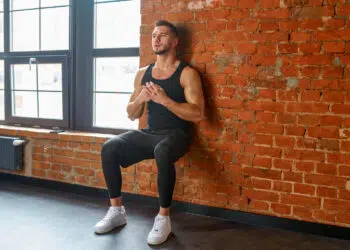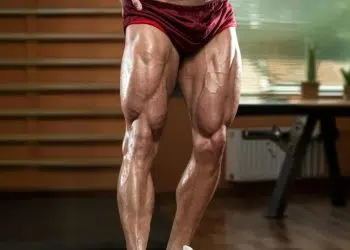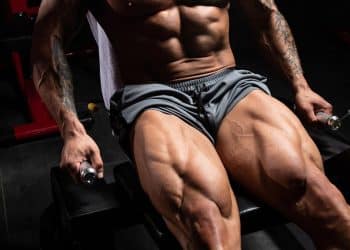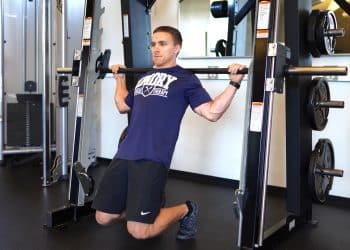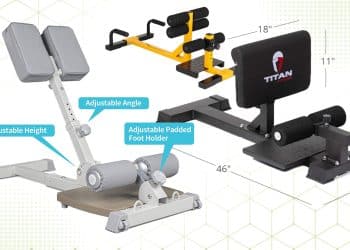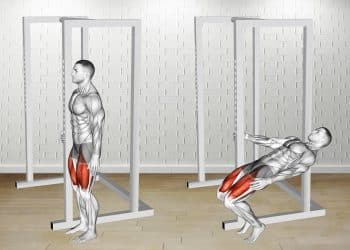We’re often told that big compound or multijoint exercises are the best way to build muscle size and strength. Examples of compound exercises include squats, bench presses, push-ups, and pulldowns.
These compound exercises allow you to lift the heaviest weights and are usually very functional, meaning they replicate the actions of daily life or sports.
But, while compound exercises are undeniably effective, the fact they involve multiple muscles and joints can also be something of a drawback.
For example, suppose you want to increase the size of your quads, but your glutes and hamstrings are already well-developed. More squats, leg presses, lunges, etc., will increase size in your entire lower body and not just your quads. As such, the front of your thighs will always be overshadowed by your bigger hammies and glutes, as all your leg muscles will probably grow at the same rate.
With isolation and semi-isolation exercises, you can preferentially target specific muscles so you can build and sculpt them according to your needs and goals.
In this article, we reveal the seven best knee extension exercises for building bigger, stronger quadriceps.
Level Up Your Fitness: Join our 💪 strong community in Fitness Volt Newsletter. Get daily inspiration, expert-backed workouts, nutrition tips, the latest in strength sports, and the support you need to reach your goals. Subscribe for free!
Knee Extension Exercises – Muscles Worked
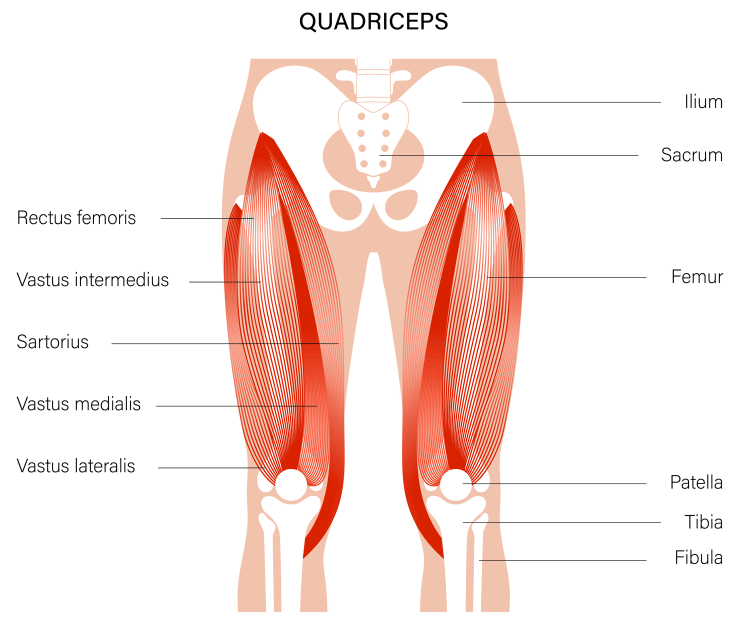
Knee extension is the biomechanical term for straightening your legs. The muscles responsible for this action are your quadriceps or quads for short. There are four quadriceps muscles, and their names are:
- Vastus lateralis (outside of the thigh)
- Vastus medialis (inside of the thigh)
- Vastus intermedius (middle of the thigh)
- Rectus femoris (length of the thigh)
Each of the quadriceps has its own unique origin point. The three vastus muscles originate at different points on your femur or thigh bone, while the rectus femoris originates from the front of the lower pelvis. Because the rectus femoris crosses the hip as well as the knee, in addition to being a knee extensor, it is also a hip flexor.
All four quadriceps come together at a single insertion point on your tibia or shin bone, just below your knee.
All compound leg exercises involve an element of knee extension, but many also involve hip extension. However, there are several exercises that only feature knee extension or involve more knee extension than hip extension. It’s these latter exercises that are the subject of this article.
7 Best Knee Extension Exercises
Not sure which knee extension exercises to do? Wonder no more! Here are seven of the best quad-busting pump-inducing knee extension workout moves.
- Leg extension machine
- Dumbbell leg extensions
- Standing cable leg extensions
- Reverse Nordic curl
- Sissy squat
- Heels elevated goblet squat
- Wall squat
1. Leg extension machine
Most gyms have a leg extension machine. This popular exercise provides a safe and convenient way to perform knee extensions and isolate your quads. Bodybuilders use leg extensions to increase quadriceps size, but they can also be used by anyone looking to improve general thigh strength.
Steps:
- Sit on the leg extension machine so your knees are aligned with the lever arm pivot point. Adjust the backrest and ankle pad for comfort. Brace your core.
- Smoothly extend your legs until your knees are straight.
- Pause at the top of the rep for 1-2 seconds and squeeze your quads.
- Bend your legs but do not allow the weight plates to touch down.
- Continue for the desired number of reps.
Muscles Targeted:
- Primary: Quadriceps.
- Secondary: N/A.
Benefits:
- A very straightforward knee extension exercise that’s ideal for beginners.
- Infinitely scalable by adjusting the weight up or down.
- A very accessible exercise as most gyms have a leg extension machine.
Tips:
- Pull your toes up toward your shins to maximize quadriceps engagement.
- Pause at the top of each rep to get more from this exercise.
- You can also do single-leg and alternating-leg extensions.
2. Dumbbell leg extensions
While machine leg extensions are one of the best ways to isolate your quadriceps, you probably won’t have access to one if you train at home. After all, even compact leg extension machines are big and expensive. The good news is that you can replicate this popular machine with nothing more than a dumbbell and an exercise bench.
Steps:
- Sit on a flat exercise bench with your legs together and your knees on the edge.
- Clamp a dumbbell between your feet.
- Squeezing your knees together, extend your legs so your knees are straight.
- Bend your legs to 90 degrees and repeat.
Muscles Targeted:
- Primary: Quadriceps.
- Secondary: Adductors, tibialis anterior.
Benefits:
- An accessible alternative to machine leg extensions for home workouts.
- A low-tech but high-effect knee extension exercise.
- An effective way to target your quadriceps.
Tips:
- Wrap a towel around your dumbbell to protect your ankles.
- Tie the dumbbell in place with a yoga strap or resistance band to avoid dropping it.
- You can also do this exercise with ankle weights instead of a dumbbell.
3. Standing cable leg extensions
Seated leg extensions are very effective for targeting the vastus lateralis, vastus medialis, and vastus intermedius muscles. However, they’re not so good for hitting the rectus femoris. Sitting with your hips flexed puts the rectus femoris in a relaxed position, so it cannot produce much power. Standing cable leg extensions ensure all four quads get an equal workout.
Steps:
- Put on an ankle strap and attach it to a low cable machine. Turn so your back is to the weight stack. Take 1-2 steps forward to tension the cable.
- Bend your leg and move your hip backward into extension.
- Next, drive your leg forward and extend your knee against the resistance offered by the cable.
- Return to the starting position and repeat.
- Switch legs and do the same number of reps on the opposite side.
Muscles Targeted:
- Primary: Quadriceps.
- Secondary: Hip flexors, core.
Benefits:
- An excellent exercise for athletes, especially martial artists and soccer players.
- One of the few exercises that hits all four quads equally.
- Good for developing knee mobility, hip stability, and quadriceps flexibility.
Tips:
- Keep your core braced to stabilize your lumbar spine and hips.
- Hold onto something sturdy for balance, e.g., the back of an upright exercise bench.
- You can also do this exercise with a resistance band.
4. Reverse Nordic curl
Nordic curls are usually associated with hamstring training. In fact, they’re arguably one of the best bodyweight hamstring exercises around. However, there is a Nordic curl variation that targets the quads and works like a natural leg extension machine. Like its hammie-hitting cousin, the reverse Nordic curl is a challenging and effective exercise.
Steps:
- Kneel down so your thighs and torso are vertical. Your knees should be roughly hip-width apart. Brace your core.
- Keeping your hips extended, lean back as far as you can.
- Drive your feet into the floor and return to the upright position.
- Continue for the prescribed number of reps.
Muscles Targeted:
- Primary: Quadriceps.
- Secondary: Hip flexors, core.
Benefits:
- Works all four quads muscles, including the hard-to-train rectus femoris.
- An ideal exercise for home workouts.
- Good for improving knee mobility and quadriceps flexibility.
Tips:
- Adjust your range of motion based on your flexibility and knee health.
- Kneel on a folded exercise mat or foam pad for comfort.
- Hold a weight across your chest to make this exercise more demanding.
5. Sissy squat
The sissy squat is an old-school bodybuilding exercise. Despite its somewhat disparaging name, the sissy squat is far from easy and provides a very effective way to overload your quads and work on your knee extension strength.
Steps:
- Stand with your feet about hip-width apart. Hold a sturdy post or wall for balance. Brace your core.
- Rise up onto your tip toes, push your knees forward, lean back, and squat down as deeply as you can. Try to touch your knees to the floor in front of your feet.
- Drive the balls of your feet into the floor and extend your knees to stand up.
- That’s one rep – keep going!
Muscles Targeted:
- Primary: Quadriceps.
- Secondary: Hip flexors, hamstrings, gluteus maximus.
Benefits:
- A bodyweight equivalent to the leg extension machine.
- A very challenging knee extension exercise.
- An excellent exercise for home workouts.
Tips:
- Adjust your range of motion according to your flexibility and knee health.
- Hold a weight across your chest to make this exercise harder.
- Use your arms for assistance if regular sissy squats are too challenging:
6. Heels elevated goblet squat
While this is not a pure knee extension exercise, it does emphasize the quadriceps while deemphasizing your glutes and hamstrings. If you are looking to build your quads while maintaining your posterior leg muscles, this exercise will help.
Steps:
- Hold a kettlebell in front of your chest. Tuck your upper arms into your sides and brace your core.
- Stand with your feet about hip-width apart, heels on weight plates or a plank. You can also use specially designed heel wedges.
- Keeping your torso upright, bend your knees and squat down so your thighs are at least parallel to the floor. Let your knees travel forward beyond your toes.
- Drive the balls of your feet into the floor and stand back up.
- Continue for the desired number of reps.
Muscles Targeted:
- Primary: Quadriceps.
- Secondary: Hamstrings, gluteus maximus, core.
Benefits:
- You don’t need a lot of weight to benefit from this knee-extension exercise.
- An easy way to overload your quads while saving your hamstrings and glutes.
- An excellent exercise for home workouts as you only need a single kettlebell to do it.
Tips:
- The more you raise your heels, the more quads-centric this exercise becomes.
- Experiment with the width of your stance to see what works best for you.
- You can also do this exercise with a dumbbell.
Read more: Heels elevated goblet squats guide.
7. Wall squat
Wall squats are an isometric exercise, meaning your muscles generate force but do not change length. Isometric exercises are ideal for home workouts as they require little or no equipment. Done the way described below, wall squats are an excellent knee extension exercise.
Steps:
- Stand with your back to a smooth wall. Lean against it and then slide down until your thighs are roughly parallel to the floor. Your shins should be vertical.
- Push your lower back into the wall as hard as you can. Imagine you are trying to push your feet forward and away from you.
- Keep pushing for the specified duration and then relax.
Muscles Targeted:
- Primary: Quadriceps.
- Secondary: Hamstrings, gluteus maximus.
Benefits:
- A very joint-friendly knee extension exercise.
- No equipment required, so an ideal exercise for home workouts.
- As hard as you make it – push harder for a more intense workout or ease off to make it less demanding.
Tips:
- Change squat depth to hit your quads from a range of angles.
- Push as hard as possible to develop muscle strength and size or hold for longer to develop muscular endurance.
- You can also do this exercise on one leg, like this:
Knee Extension Benefits
Not sure if knee extension exercises are worth adding to your workouts? Consider these benefits and then decide!
Increased quadriceps mass and strength
Well-developed quadriceps can add a lot to your physique. The quadriceps are the triceps of the lower body, and the more muscular they are, the better your legs will look. The quads are also a critical muscle for squatting and leg pressing big weights, so if you want to put more plates on the bar, you may benefit from bigger, stronger quads.
Better athletic performance
Whether you want to run faster, jump higher, or kick harder, stronger quads will help. Compound exercises will improve general leg strength, but knee extension exercises are the best choice when you want to emphasize your quadriceps.
Stronger, more stable knees
The quads are not just knee extensors. They are also knee joint stabilizers. This is especially true for the vastus medialis, which is crucial in ensuring your knee tracks correctly. Strengthening your quads with knee extension exercises could help prevent joint wear and tear and reduce your risk of developing knee pain in the future.
Drawbacks
While knee extension exercises are mostly safe and beneficial, there are also a few drawbacks to consider:
Risk of knee injury
At the risk of being contradictory, knee extension exercises can be good for your knees, but they can also cause knee pain.
Level Up Your Fitness: Join our 💪 strong community in Fitness Volt Newsletter. Get daily inspiration, expert-backed workouts, nutrition tips, the latest in strength sports, and the support you need to reach your goals. Subscribe for free!
With only one joint bearing the brunt of the workload, some knee extension exercises can be hard on your knees. However, warming up properly, not using too much weight, and always using good form will keep any risks of knee pain to a minimum.
Not as functional
Most everyday and athletic lower body movements involve the hips and knees working together. This is your body’s way of maximizing performance and spreading the work across several joints and muscle groups.
For example, lifting a heavy weight using your knees, hips, spine, and arms is much easier than relying on your arms alone.
As such, some knee extension exercises are not as functional as other multijoint leg exercises. That said, if your goal is to emphasize your quads while using your glutes and hamstrings less, knee extension exercises are still your best option.
FAQs
Do you have a question about the 7 best knee extension exercises or lower body training in general? That’s okay because we’ve got the answers!
1. Are knee extension exercises safe?
All exercises have the potential to be dangerous if you perform them with poor technique or use too much weight. Accidents can also happen, and even seemingly benign exercises can sometimes result in injury.
While some knee extension exercises put a lot of stress on your knee joints, that doesn’t mean they’re automatically risky or dangerous. That stress could help make your joints stronger and more resilient.
That said, if you have a pre-existing knee problem or any of the exercises described above cause pain, you should proceed with caution. Choose the exercises that give you the best results with the least amount of risk.
Make your chosen exercises even safer by always warming up beforehand and never using more weight than you can handle with good form.
2. How often should I do knee extension exercises?
It’s generally best to train major muscle groups twice a week, e.g., Monday and Thursday. This provides a good balance between work and recovery. However, it’s usually best to avoid doing the same exercises for both workouts. Such an approach will soon become boring.
Instead, create two different programs so that your workouts are less repetitive and you train your muscles from a variety of angles.
3. How many reps and sets of knee extension exercises should I do?
Your rep range is not as important as was once thought. Not so long ago, it was generally accepted that to build muscle, you had to work in the 6-12 rep range, and anything outside this range meant your workouts would be less productive.
More recently, studies have shown that you can build muscle with almost any rep count, provided you take your sets close to failure (1). Even high reps with light weights build muscle. This is excellent news for home exercisers and anyone who prefers to avoid heavy lifting.
However, heavy weights are still best if you want to get stronger, and low reps (e.g., 1-5) are more effective than high reps for developing maximal strength.
Regarding the number of sets, you should be able to fatigue your muscles with 3-4 sets of your chosen exercises. If you feel like you need to do more, you have either been resting too long between efforts or not getting close enough to failure.
4. What is the best way to warm up for knee extension exercises?
Given that most knee extension exercises put a lot of stress on your joints, it makes sense to warm up thoroughly before doing any of them. Warming up increases muscle elasticity and blood flow while improving joint mobility.
The best way to warm up before knee extension exercises (and any strength workout) is:
- 5-10 minutes of progressive cardio, e.g., walking, jogging, and then running or slow, medium, and fast cycling.
- Dynamic mobility and flexibility exercises for the joints and muscles you’re about to train.
- A couple of light sets of the first 1-2 exercises in your workout for practice and to increase muscle activation.
Read more about warming up for strength training here.
5. Do you have a knee extension workout for me to try?
We sure do! Give this workout a spin the next time you want to pulverize your quads.
| Exercise | Sets | Reps | Recovery | |
| 1a | Reverse Nordic curls | 3 | 12-20 | 90 seconds |
| 1b | Sissy squats | 8-12 | ||
| 2 | Cable leg extensions | 2 | 12-20 | 60 seconds |
| 3 | Heels elevated goblet squat | 2 | 8-12 | 60 seconds |
| 4 | Wall squat | 1 | Max time | N/A |
Perform exercises 1a and 1b as a superset. Do the first exercise and then immediately do the second. Rest a moment, and then repeat the superset a couple more times. And yes, that burning in your quads is entirely normal!
Wrapping Up
Glute and hamstring training are very popular right now, with many exercisers wanting to build a strong and muscular posterior chain. Because of this, quads training has fallen a little out of fashion.
After all, when you dedicate entire workouts to your butt and hammies, it doesn’t leave much time for training your other leg muscles.
While it’s great that the posterior chain is finally getting the attention it deserves, this doesn’t mean that you should neglect your knee extensors. In fact, your quadriceps are every bit as important as your glutes and hamstrings.
Use the information in this article to ensure your quads are just as strong and well-developed as your posterior chain.
References:
1 – PubMed: Effects of different intensities of resistance training with equated volume load on muscle strength and hypertrophy https://pubmed.ncbi.nlm.nih.gov/29564973/
Interested in measuring your progress? Check out our strength standards for Bench Press, Push Ups, Goblet Squat, and more.


